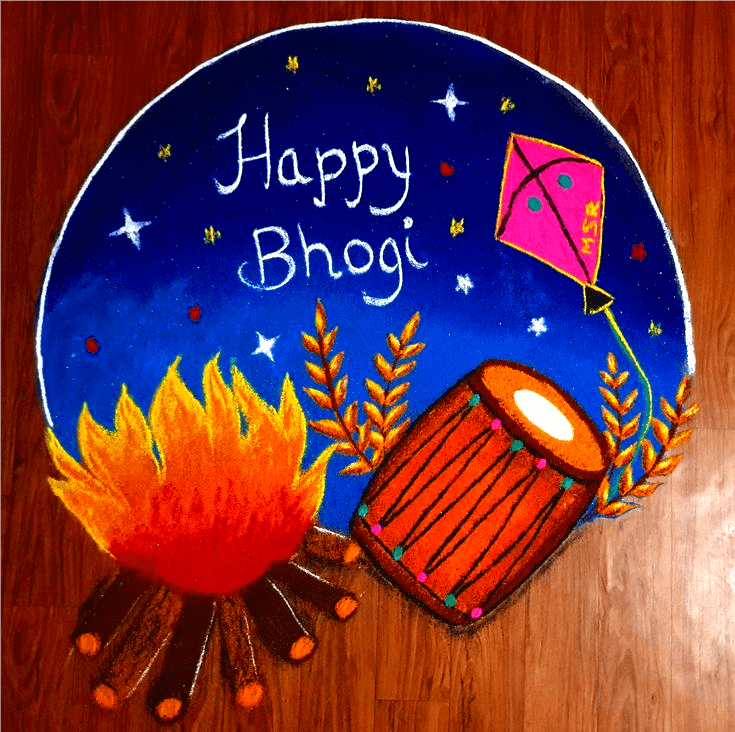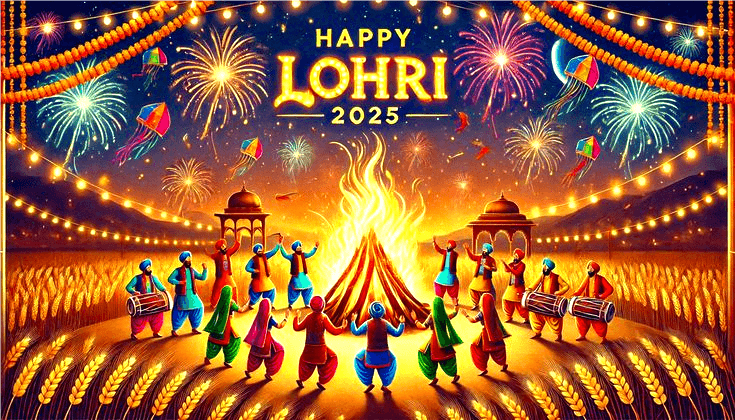Table of Contents
In the southern states of India, Bhogi marks the commencement of the harvesting festival Sankranti. It is the time for new beginnings, sacrifices and abundance. The designing of Bhogi mugggulu, or the traditional rangoli types, used to decorate entrances of houses fills me with joy also. These patterns are intricate fusions of cultural aesthetic, artistic prowess and utter devotion that the designers possess.
Purpose of Bhogi Muggulu
Just like rangoli’s Bhogi mugggulu are not only patterns that aim to beautify but also boast a deeper meaning that is intertwined with culture and spirituality. If we use rice flour to create muggulu, we embed abundance and luck around the home. Traditionally, rice flour was used as an offering to ants and other insects, giving thanks to nature and establishing oneness with nature.
Adding to that, making Bhogi Muggulu is an extension of starting afresh. Bhogi is when the household and old belongings are disposed of, and it is the right frame of mind to begin anew. The use of color and vibrancy of the muggulu’s made near the doorstep represents that and also pays respect to gods and makes guests feel welcomed.
Materials Used for Bhogi Muggulu
The materials for Bhogi Muggulu are simple yet significant. Muggulu devotees would grind grains such as rice, ragi, or any other type of cereal and mix it with water to form useable dough for creating Muggulu. In today’s world however, many people have transformed the traditional grain-based muggulu into more vivid and colorful works by incorporating colored powders, powdered chalk or flower petals into the mix.
Cow dung is often considered to have ‘Tama’ qualities for muggulu, which assists in its purification. It is considered auspicious and thus, mixing it with water and sprinkling it serves as an ideal base for muggulus.
Bhogi Muggulu is often further beautified with materials such as turmeric, earthen lamps or kumkum (red powder made from dried turmeric), supplemented to the final design.
Designs and Patterns in Bhogi Muggulu
The Muggulu range is quite broad in complexity and Bhogi Muggulu is no different. With muggulu being abstract art, they can be highly intricate. However, it depends on the nature of the design, here are some ways to visualize possible variations of muggulu:
Geometric Patterns: Easily the most sought out and appealing, muggulu with symmetrical variations of circles, squares, triangles and similar types of geometric designs is also quite famous.
Dotted Muggulu: Designed to be versatile, this form of muggulu style involves connecting simple dots in a ordered grid sealed by geometric shapes that can range from complex to basic designs.
Nature-Inspired Motifs: Similar to Mughulah, paint sprays featuring more themes such as flowers, leaves, birds and even peacocks can also be incorporated.
Traditional Symbols: Just like the conventional muggulu, The mughulah can feature elements such as pots or Mango leaves which can serve as signs of harvest and abundance.
Special Designs for the Occasion: The Sun pattern is one of the special patterns that are generally used on Bhogi since the sun is one of the main gods at the time of Sankranti.
How to Draw Bhogi Muggulu
Bhogi Muggulu is a meditative process as well as an enjoyable task that can easily be accomplished. Follow the steps below to draw one:
Normal Areas: Get rid of the area that the muggu is to be drawn on. It is optional to moisten the ground and spread a thin layer of cow dung paste.
Choosing The Design: Choose the pattern to be drawn. One can start with simple patterns if they are beginners, while complex patterns can be attempted by more experienced painters.
Dotting Designs: For use of dotted designs, Professional muggulu artists The use of a grid makes it easier to evenly distribute the dots across the area.
Where To Put The Pattern: Look for places where the dots could be connected with rice powder or colored powder so that the desired shapes can be formed.
Decorations: To make the muggu more impressive, other decorations, additional colors and lights can be used to make it festive.
Newer Ways Of Doing Bhogi Muggulu
Modern ways to Bhogi Muggulu art have added another aspect to the age-old tradition of drawing muggulu. There is a greater desire to use colored powders and flower petals to create rustic or saturated yet visually appealing designs. Some individuals prefer using stencils, especially when urban areas are congested and there is a shortage of time and space.
Bhogi Muggulu has become even more popular, thanks to social media and the community’s trending competitions. People are able to share their ideas and show off their innovation, thus ensuring that the tradition remains alive in a myriad of ways.
Bhogi Muggulu: A Social Connect
The art of crafting Bhogi Muggulu is usually a family affair. It helps strengthen the bonds of unity and the togetherness of people and is fun. Early on the day of the Bhogi festival, the women and children would come together to draw muggulu, brainstorm on ideas lifting up the togetherness spirit with gales of laughter and conversation.
Preserving the Tradition
Society changes and with it, the customs of drawing muggulu. Regardless, efforts are underway to maintain this form of art. The younger generations are taught about the significance and styles of drawing muggulu through workshops that are organized by schools and other cultural organizations. And thus the cycles continues. Festivals along with competitions encourage people and help in safeguarding the tradition.

Conclusion
Bhogi Muggulu isn’t just a design; they portray passion, culture, and worship. They respect the ancient heritage, yet allow for modern adaptations, these visuals merge yesterday with today. As the family sits together to create these masterpieces, they pay respect to their ancestors, foster innovation, and invite wealth into their dwelling. This Bhogi, take a second to consider the sophisticated nature of muggulu as well as the epitomes of values that they portray.
If you are interested for more: “Bappam: Marathi Cultural Affectionate Term for Lord Ganesha” “7 Powerful Reasons Bhogi Muggulu Are More Than Just Art: Tradition, Culture, and Creativity Unveiled”





